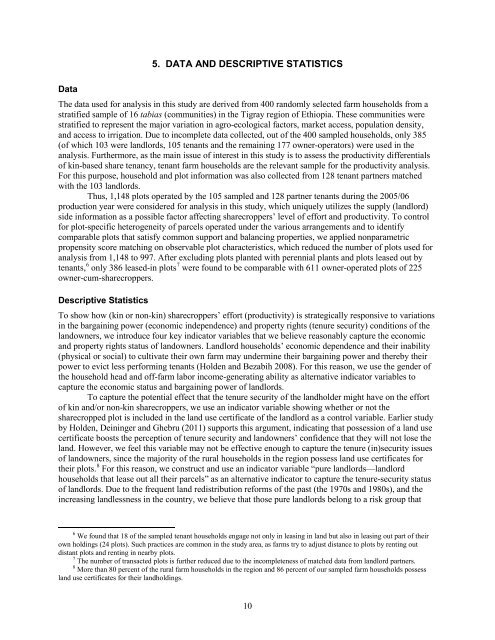Reverse-Share-Tenancy and Marshallian Inefficiency - International ...
Reverse-Share-Tenancy and Marshallian Inefficiency - International ...
Reverse-Share-Tenancy and Marshallian Inefficiency - International ...
You also want an ePaper? Increase the reach of your titles
YUMPU automatically turns print PDFs into web optimized ePapers that Google loves.
5. DATA AND DESCRIPTIVE STATISTICS<br />
Data<br />
The data used for analysis in this study are derived from 400 r<strong>and</strong>omly selected farm households from a<br />
stratified sample of 16 tabias (communities) in the Tigray region of Ethiopia. These communities were<br />
stratified to represent the major variation in agro-ecological factors, market access, population density,<br />
<strong>and</strong> access to irrigation. Due to incomplete data collected, out of the 400 sampled households, only 385<br />
(of which 103 were l<strong>and</strong>lords, 105 tenants <strong>and</strong> the remaining 177 owner-operators) were used in the<br />
analysis. Furthermore, as the main issue of interest in this study is to assess the productivity differentials<br />
of kin-based share tenancy, tenant farm households are the relevant sample for the productivity analysis.<br />
For this purpose, household <strong>and</strong> plot information was also collected from 128 tenant partners matched<br />
with the 103 l<strong>and</strong>lords.<br />
Thus, 1,148 plots operated by the 105 sampled <strong>and</strong> 128 partner tenants during the 2005/06<br />
production year were considered for analysis in this study, which uniquely utilizes the supply (l<strong>and</strong>lord)<br />
side information as a possible factor affecting sharecroppers’ level of effort <strong>and</strong> productivity. To control<br />
for plot-specific heterogeneity of parcels operated under the various arrangements <strong>and</strong> to identify<br />
comparable plots that satisfy common support <strong>and</strong> balancing properties, we applied nonparametric<br />
propensity score matching on observable plot characteristics, which reduced the number of plots used for<br />
analysis from 1,148 to 997. After excluding plots planted with perennial plants <strong>and</strong> plots leased out by<br />
tenants, 6 only 386 leased-in plots 7 were found to be comparable with 611 owner-operated plots of 225<br />
owner-cum-sharecroppers.<br />
Descriptive Statistics<br />
To show how (kin or non-kin) sharecroppers’ effort (productivity) is strategically responsive to variations<br />
in the bargaining power (economic independence) <strong>and</strong> property rights (tenure security) conditions of the<br />
l<strong>and</strong>owners, we introduce four key indicator variables that we believe reasonably capture the economic<br />
<strong>and</strong> property rights status of l<strong>and</strong>owners. L<strong>and</strong>lord households’ economic dependence <strong>and</strong> their inability<br />
(physical or social) to cultivate their own farm may undermine their bargaining power <strong>and</strong> thereby their<br />
power to evict less performing tenants (Holden <strong>and</strong> Bezabih 2008). For this reason, we use the gender of<br />
the household head <strong>and</strong> off-farm labor income-generating ability as alternative indicator variables to<br />
capture the economic status <strong>and</strong> bargaining power of l<strong>and</strong>lords.<br />
To capture the potential effect that the tenure security of the l<strong>and</strong>holder might have on the effort<br />
of kin <strong>and</strong>/or non-kin sharecroppers, we use an indicator variable showing whether or not the<br />
sharecropped plot is included in the l<strong>and</strong> use certificate of the l<strong>and</strong>lord as a control variable. Earlier study<br />
by Holden, Deininger <strong>and</strong> Ghebru (2011) supports this argument, indicating that possession of a l<strong>and</strong> use<br />
certificate boosts the perception of tenure security <strong>and</strong> l<strong>and</strong>owners’ confidence that they will not lose the<br />
l<strong>and</strong>. However, we feel this variable may not be effective enough to capture the tenure (in)security issues<br />
of l<strong>and</strong>owners, since the majority of the rural households in the region possess l<strong>and</strong> use certificates for<br />
their plots. 8 For this reason, we construct <strong>and</strong> use an indicator variable “pure l<strong>and</strong>lords—l<strong>and</strong>lord<br />
households that lease out all their parcels” as an alternative indicator to capture the tenure-security status<br />
of l<strong>and</strong>lords. Due to the frequent l<strong>and</strong> redistribution reforms of the past (the 1970s <strong>and</strong> 1980s), <strong>and</strong> the<br />
increasing l<strong>and</strong>lessness in the country, we believe that those pure l<strong>and</strong>lords belong to a risk group that<br />
6 We found that 18 of the sampled tenant households engage not only in leasing in l<strong>and</strong> but also in leasing out part of their<br />
own holdings (24 plots). Such practices are common in the study area, as farms try to adjust distance to plots by renting out<br />
distant plots <strong>and</strong> renting in nearby plots.<br />
7 The number of transacted plots is further reduced due to the incompleteness of matched data from l<strong>and</strong>lord partners.<br />
8 More than 80 percent of the rural farm households in the region <strong>and</strong> 86 percent of our sampled farm households possess<br />
l<strong>and</strong> use certificates for their l<strong>and</strong>holdings.<br />
10
















